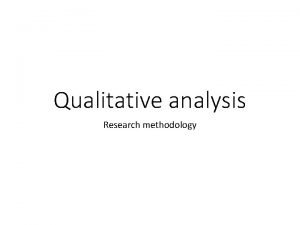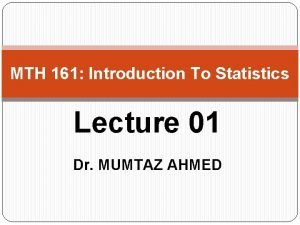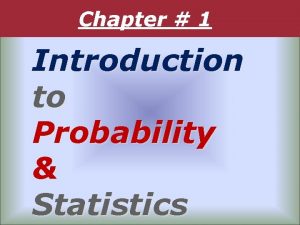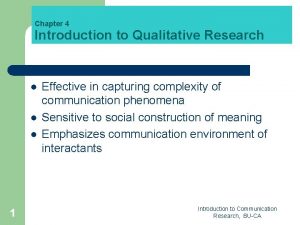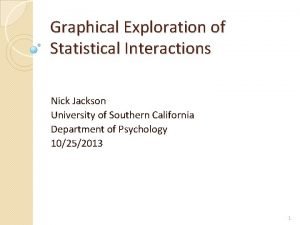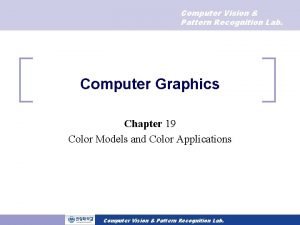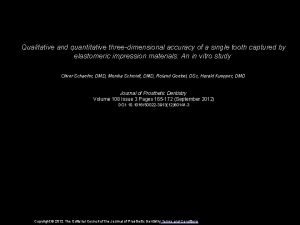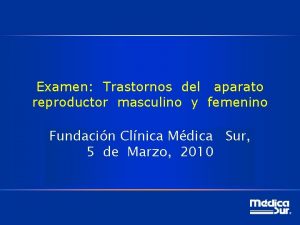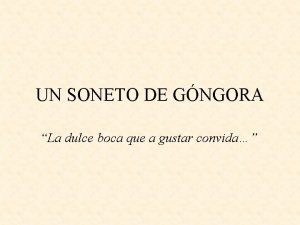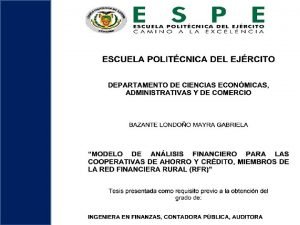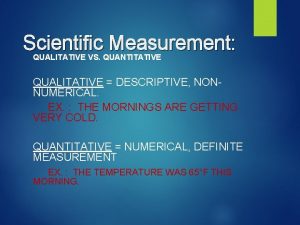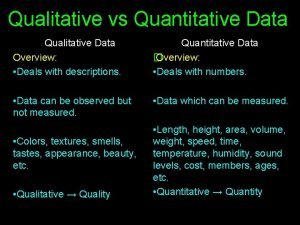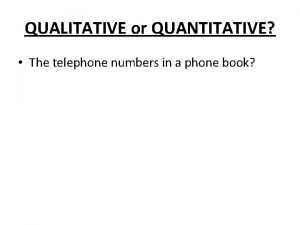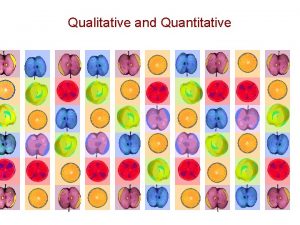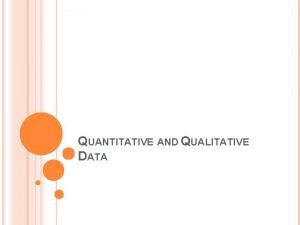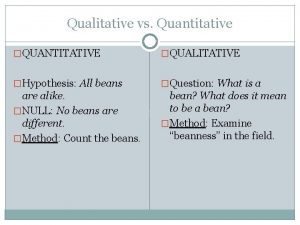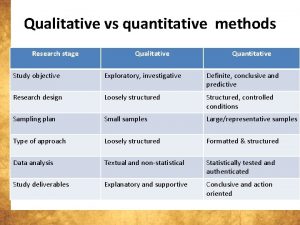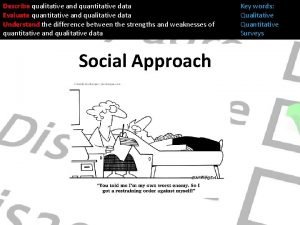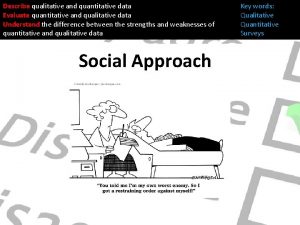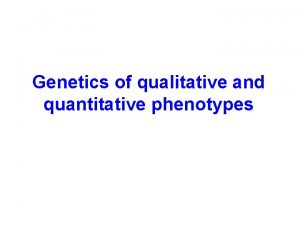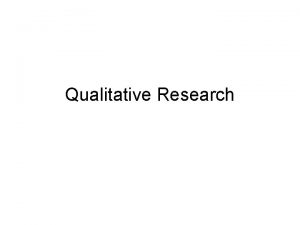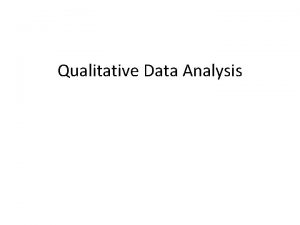Quantitative and Qualitative Approaches Francisco Perlas Dumanig Ph







































- Slides: 39

Quantitative and Qualitative Approaches Francisco Perlas Dumanig, Ph. D.

What is quantitative and qualitative research? Quantitative Research a type of research in which the researcher 1. 2. 3. 4. 5. decides what to study asks specific, narrow questions collects numeric data from participants analyzes these numbers using statistics conducts the inquiry in an unbiased, objective manner

Qualitative research A type of research in which the researcher relies on the following: 1. 2. 3. 4. 5. views of participants, ask broad, and general questions, collects data consisting largely of words (or text) from participants, describes and analyzes these words for themes, conducts the inquiry in a subjective, biased manner.

Common characteristics that distinguish Quantitative from Qualitative: Identifying a Research Problem; Quantitative research tells to address research problems requiring: A description of trends or an explanation of the relationship among variables.

Qualitative research tends to address research problems requiring: An exploration in which little is known about the problem and a detailed understanding of a central phenomenon.

Reviewing the Literature In quantitative research, the literature tends to: 1. Provide a major role through suggesting the research questions to be asked. 2. Justify the research problem and create a need for the direction (purpose statement and research questions or hypothesis) of the study.

In qualitative research, the literature tends to: 1. 2. Play a minor role in suggesting a specific research question to be asked. Justify the importance of studying the research problem.

Specifying a Purpose for Research In quantitative research, the purpose statement, research questions and hypothesis tend to: 1. Be specific and narrow 2. Seek measurable, observable data on variables.

In qualitative research, the purpose statement and research questions tend to: 1. 2. Be general and broad Seek to understand the participants’ experience.

Collecting Data Quantitative data collection consists of: 1. Collecting data using instruments with preset questions and responses. 2. Gathering quantifiable (numeric) data. 3. Collecting information from a large number of individuals.

Qualitative data collection consists of: 1. 2. 3. Collecting data using forms with general, emerging questions to permit the participation to generate response. Gathering word (text) or image (picture) data Collecting information from a small number of individuals or sites

Analyzing and Interpreting Data In quantitative research, the 1. Data analysis tends to consist of statistical analysis, 2. Data tends to involve describing trends, comparing group differences, or relating variables. 3. Interpretation tends to consist of comparing results with prior predictions and past research

In qualitative research, the 1. 2. 3. Data analysis tends to consist of text analysis Data tends to involve developing a description and themes Interpretation tends to consist of stating a larger meaning of the findings.

Reporting the Research In quantitative research, the: 1. Research reports tend to use standard, fixed structures and evaluative criteria. 2. Researchers tend to take an objective and unbiased approach.

In qualitative research, the: 1. 2. Research reports tend to use flexible, emerging structure and evaluative criteria. Researchers tend to take a subjective (reflexive) and biased approach.

Quantitative and Qualitative Research l 1. 2. 3. 4. 5. 6. Both forms of research follow the six steps in the process of research. Identifying a research problem Reviewing the literature Specifying the purpose Collecting Data Analyzing and interpreting data Reporting and evaluating data

l In the section on the research problem – both quantitative and qualitative research can be similar in the topics addressed such as conveying a problem, pointing out the lack of literature on this problem, and justifying a need to study the problem. l In both quantitative and qualitative research, you collect data using interviews, observations, and documents.

What is a Research Design? l Research design can be thought of as the structure of research. l It is the "glue" that holds all of the elements in a research project together.

Research Design l It is used to structure the research, to show all of the major parts of the research project -- the samples or groups, measures, treatments or programs, and methods of assignment -- work together to try to address the central research questions.

Research Design l Is a specific procedure involved in the last three steps of the research process: data collection analysis report writing l they differ for quantitative, qualitative, and combined.

Types of Research Design Quantitative Research Design 1. Experimental Research 2. Correlational Research 3. Survey Research Qualitative Research Combined Design Qualitative/Quantitative Research Design 1. Grounded Theory Research 2. Ethnographic Research 3. Narrative Research 1. Mixed Method 2. Action Research

Experimental Design l (also known as intervention studies or group comparison studies) is a procedure of quantitative research in which the investigator determines whether an activity or materials make a difference in result for participants. l It establishes the possible cause and effect between the dependent and independent variables.

Types of Experimental Design 1. l l Between-Group Designs (Two or more groups are compared) True experiments – assign the control group and the experimental group Quasi-experiments – use the existing intact group

2. Within-Group or Individual Designs (limited participants and not possible to create more than one group) l Time series- studying one group overtime with multiple pretest and posttest measures or observations made by the researcher.

l l Repeated measures – all participants in a single group participate in all experimental treatments with each group becoming its own control. Single –subject design – involves the study of single individuals, their observation over a baseline period, and the administration of an intervention.

Steps in conducting an experimental research 1. 2. 3. 4. 5. 6. 7. 8. Decide if an experiment addresses your research problem Form hypotheses to test cause-and-effect relationships Select an experimental unit and identify study participants Select an experimental treatment and introduce it Choose a type of experimental design Conduct experiment Organize and analyze the data Develop an experimental research report

Correlational Designs l l Are procedures in quantitative research in which investigators measure the degree of association (or relation) between two or more variables using the statistical procedure of correlational analysis. They are used when a researcher seeks to relate two or more variables to see whether they influence each other.

Types of Correlational Design l Explanatory design – it is used when the researcher is interested in the extent to which variables co-vary, that is, where changes in one are reflected in changes in the other.

2. The Prediction Design – to identify variables that will positively predict an outcome or criterion.

How to conduct a correlational study? 1. 2. 3. 4. 5. 6. 7. Determine if a correlational study best addresses the research problem Identify individuals to study Identify two or more measures for each individual in the study Collect data and monitor potential threats Analyze the data and represent the results Interpret the results

Survey Designs l l Are procedures in quantitative research in which you administer a survey or questionnaire to a small group of people (called the sample) to identify trends in attitudes, opinions, behaviors, or characteristics of a large group of people (called population). They are used to describe the trends.

Grounded Theory Designs l Are systematic, qualitative procedures that researchers use to generate a general explanation (called a grounded theory) that explains a process, action, or interaction among people.

Ethnographic Designs l l Are qualitative procedures for describing, analyzing, and interpreting a cultural group’s shared patterns of behavior, beliefs, and language that develop over time. They are used when the study of a group provides understanding of a larger issue

Types of ethnographic design 1. 2. 3. Realist ethnography – an objective account of the situation, typically written in the third-person point of view, reporting objectively on the information learned from the participants at a field site. Case study Critical ethnography

Narrative Research Designs l Are qualitative procedures in which researchers describe the lives of individuals, collect and tell stories about these individual’s lives, and write narratives about their experiences.

Mixed Methods Designs l Are procedures for collecting, analyzing, and mixing both qualitative and quantitative data in a single study or in a multiple series of studies.

Action Research Designs l Are systematic procedures used by teachers (or other individuals in an educational setting) to gather quantitative data to address improvements in their educational setting, their teaching, and the learning of their students.

How to Choose Quantitative or Qualitative Approach? 1. 2. 3. Match your approach to your research problem. Fit the approach to your audience. Relate the approach to your experiences.

END
 Data collection instruments in qualitative research
Data collection instruments in qualitative research Group studied is smaller and not randomly selected
Group studied is smaller and not randomly selected Qualitative and quantitative data difference
Qualitative and quantitative data difference Quantitative vs qualitative observations
Quantitative vs qualitative observations Qualitative needs assessment
Qualitative needs assessment A qualitative variable
A qualitative variable Quantitative vs qualitative data collection
Quantitative vs qualitative data collection Types of quantitative variables
Types of quantitative variables Bicholestadien
Bicholestadien Qualitative observations vs quantitative observations
Qualitative observations vs quantitative observations Similarities between qualitative and quantitative research
Similarities between qualitative and quantitative research Similarities between qualitative and quantitative research
Similarities between qualitative and quantitative research Qualitative properties of matter
Qualitative properties of matter Qualitative and quantitative difference
Qualitative and quantitative difference Qualitative and quantitative difference
Qualitative and quantitative difference Random sampling method in quantitative research
Random sampling method in quantitative research Quantitative research design example
Quantitative research design example Quantitative and qualitative traits
Quantitative and qualitative traits Examples of qualitative research
Examples of qualitative research Disadvantage of qualitative research
Disadvantage of qualitative research Qualitative and quantitative
Qualitative and quantitative Difference between qualitative and quantitative research
Difference between qualitative and quantitative research Quantitative and qualitative in chemistry
Quantitative and qualitative in chemistry Integrating qualitative and quantitative methods
Integrating qualitative and quantitative methods Inheritance of quantitative traits
Inheritance of quantitative traits Perlas en el aparato reproductor masculino
Perlas en el aparato reproductor masculino Con perlas
Con perlas Jupiter y el garzon de ida
Jupiter y el garzon de ida Que es microfinanzas
Que es microfinanzas Un humor entre perlas destilado
Un humor entre perlas destilado Personificación
Personificación Vasti en la biblia
Vasti en la biblia Indicadores perlas y camel
Indicadores perlas y camel Qualitative data in geography
Qualitative data in geography What is holistic approach in research
What is holistic approach in research Longitudinal study qualitative or quantitative
Longitudinal study qualitative or quantitative Si unit in science
Si unit in science Qualitative or quantitative
Qualitative or quantitative Qualitative vs quantitative biology
Qualitative vs quantitative biology Phone number qualitative or quantitative
Phone number qualitative or quantitative


